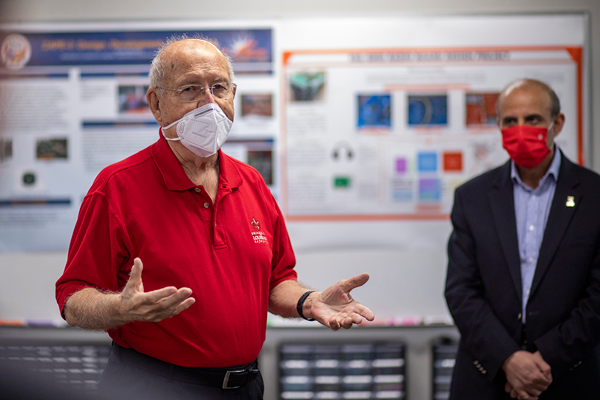Student researchers at the University of Louisiana at Lafayette have designed and built a tiny satellite for a big job – to test radiation levels in space.
A solar-powered “CubeSat” built by members of UL Lafayette’s CAPE Satellite Team will be launched during NASA’s Virgin Orbit, LauncherOne mission from Mojave, California. The space agency has yet to set a launch date. Tentative plans call for it to happen by year’s end.
Once the University’s CAPE-3 satellite arrives in space, a spring-loaded mechanism will eject it 225 miles above the Earth’s surface. The small satellite – about 10 centimeters square – will circle the globe about every 90 minutes at 17,000 miles per hour.
Along the way, the satellite will dredge the atmosphere for radiation levels with two instruments – a plastic prototype chip about the size of a pencil eraser and a small Geiger counter.
“Measurements from each will be compared to validate the efficiency and accuracy of the prototype,” said Dr. Paul Darby, the project leader. Darby is an assistant professor in the University’s Department of Electrical and Computer Engineering.
Findings could help in the development of small, chip-based radiation detectors for astronauts. The detectors would provide continuously updated liquid crystal display readings on credit card-like devices that could be placed in a pocket, or in instruments similar to wristwatches.
The technology would enable astronauts to continuously monitor the amount of radiation they are being exposed to, Darby explained. In the case of dangerously high levels, it would alert them that they’re “probably going home on the next return flight.”
The first leg of CAPE-3’s journey began earlier this month. The satellite was sent to a NASA facility in Long Beach, California, where it was inspected and approved.
On Monday, the project received another thumbs up – from University alum Jay Honeycutt, who received a bachelor’s degree in electrical and computer engineering in 1960. He is former director of NASA’s Kennedy Space Center and former president of Lockheed Martin Space Operations Co.
Honeycutt met with CAPE-3 team members in the Department of Electrical and Computer Engineering’s Nick Pugh Aerospace Electronics Research Laboratory to learn about their project. He also discussed his aerospace career.
Honeycutt said participation in the CAPE Satellite Program gives students “a tremendous advantage when they enter the work force.”
“This isn’t straightforward lab research based on what they’re learning in the classroom. They are applying what they learn. This sort of direct application – rather than just demonstrating principles – will benefit them greatly,” Honeycutt said.
The project is part of NASA’s CubeSat Launch Initiative. The initiative enables universities to conduct scientific investigations in space; it pairs NASA, in turn, with partners who assist the space agency with technology development research.
With the launch of CAPE-1 in 2007, UL Lafayette became the first university in the state whose students designed, built and launched a working satellite that orbited Earth. CAPE-2 followed in 2013.
UL Lafayette’s CAPE satellites are named for the Cajun Advanced Picosatellite Experiment program. The interdisciplinary program is designed to help students majoring in disciplines such as computer science, electrical engineering, physics and mechanical engineering prepare for a range of careers.
CAPE team member Hayden Hulin, a junior mechanical engineering major, said the program is also designed to spur interest in STEM careers among elementary-, middle- and high-school students. STEM is an acronym that stands for Science, Technology, Engineering and Mathematics.
Team members will visit area high schools to teach students about satellite technology and their research once the project is in orbit.
“It’s an important component of the initiative, because it gives younger students a chance to see what real engineering, or computer science, or physics, is all about. It’s a growing and learning opportunity for them as well,” Hulin said.
Learn more about UL Lafayette’s CAPE Satellite Program and NASA’s Cube Sat Launch Initiative.
Photo caption: University alum Jay Honeycutt, former director of NASA’s Kennedy Space Center, visited with members of UL Lafayette’s CAPE Satellite Team to discuss his aerospace career and learn about their research. The interdisciplinary team has built a small satellite that NASA will launch into space to test radiation levels. Also pictured is Dr. Ahmed Khattab, dean of UL Lafayette’s College of Engineering. Photo credit: Rachel Rafati / University of Louisiana at Lafayette

